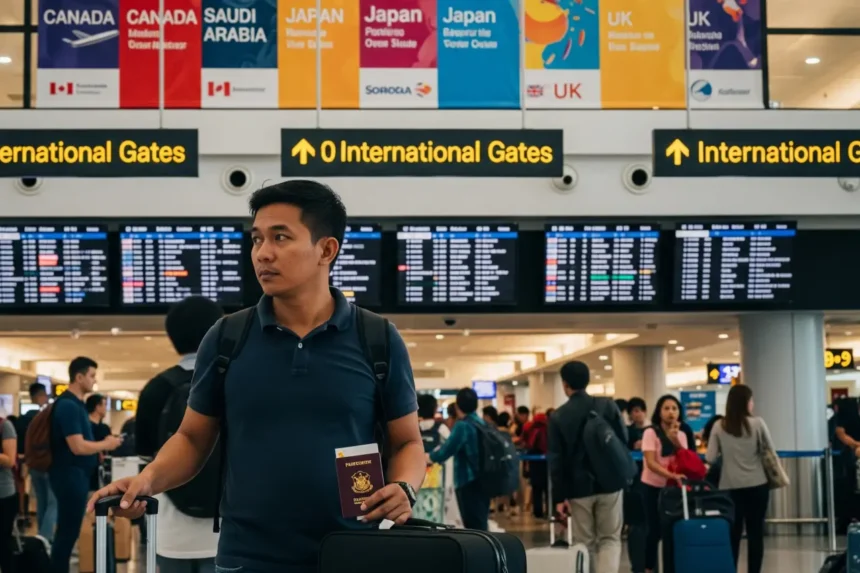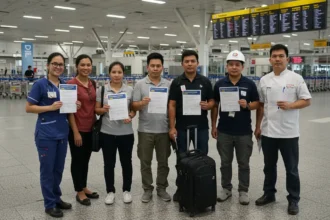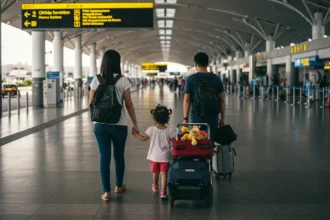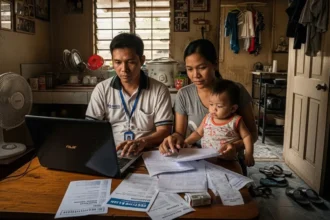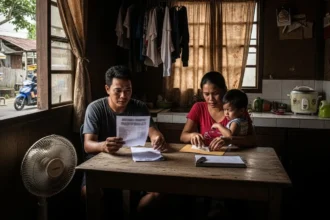Every Filipino dreaming of working abroad has a different goal. Some want to save as much money as possible so they can build a house, send kids to school, or start a business back home. Others are looking for a new life overseas – a chance to bring their families, become permanent residents, and eventually citizens. And for many, it’s about gaining skills and experience in advanced countries so they can climb the career ladder and secure better opportunities for the future.
- 🧭 Criteria for Ranking the Best OFW Destinations
- 1. Saudi Arabia
- 2. United Arab Emirates (UAE)
- 3. Qatar
- 4. Canada
- 5. Australia
- 6. New Zealand
- 7. United Kingdom
- 8. Singapore
- 9. Japan
- 10. Germany
- Comparison of Top 10 OFW Destinations in 2025
- 🧭 How to Choose the Right Country for You
- ❓ Frequently Asked Questions about OFW Destinations in 2025
- 📚 References
- 🌟 Making the OFW Journey Count
That’s why the “best” country for an OFW isn’t the same for everyone. The right destination depends on your personal goal. In this 2025 guide, we’ll go beyond a simple list of salaries. Instead, we’ll group the Top 10 OFW Destinations into three categories:
-
🌍 The Super Savers – Countries where you can earn well, spend little, and save big.
-
🏡 The Immigrants – Countries that offer clear pathways to permanent residency and citizenship.
-
📈 The Skill Builders & Career Climbers – Countries where you can gain global experience, advanced training, and career growth.
By the end of this article, you’ll know not just where Filipinos are going in 2025, but also which country fits your own life goal as an OFW.
🧭 Criteria for Ranking the Best OFW Destinations
Not all OFW journeys look the same. Some Filipinos want to save quickly and return home, others dream of migrating with their families, while many aim to build global careers. That’s why our list of the Top 10 OFW Destinations in 2025 is based on real, practical criteria that matter most to kababayan:
1. Salary vs. Cost of Living
It’s not just about how high the pay is, but also how much you can save after expenses. Countries that offer free food and accommodation (like many in the Middle East) give OFWs bigger remittance potential.
2. Benefits & Worker Rights
Does the country provide health insurance, days off, vacation leave, or family benefits? Are there clear labor protections for foreign workers? These make a huge difference in long-term well-being.
3. Demand for Filipino Workers
Certain countries consistently hire Filipinos for specific roles – from domestic helpers and caregivers to engineers, IT professionals, and healthcare staff. We prioritized countries where demand remains strong in 2025.
4. Pathways to Permanent Residency
For Filipinos dreaming of a long-term life abroad, we considered which countries have clear immigration programs that can lead to permanent residency or even citizenship.
5. Safety & Quality of Life
We factored in worker safety, cultural acceptance, legal protections, and the general living environment. A higher salary isn’t worth it if risks and stress levels are too high.
6. Accessibility & Application Process
How easy is it to apply for a job there? Do you need to pass a language test, or is it simpler via a POEA-accredited agency? We highlight countries where Filipinos have a realistic chance of getting deployed.
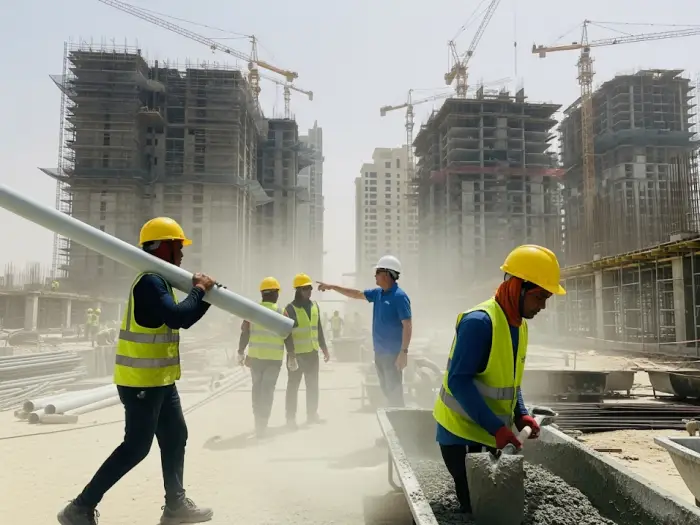
1. Saudi Arabia
Saudi Arabia has long been the #1 destination for OFWs, hosting over a million Filipinos. The kingdom relies heavily on foreign workers, and Filipinos are in demand for their skills, work ethic, and adaptability. What makes Saudi especially attractive is its tax-free salaries, plus the fact that most employers cover housing, meals, and even transportation. This means that even if salaries aren’t as high as in Western countries, OFWs can save much more of their income and send larger remittances to their families back home.
In-Demand Jobs in 2025
-
Domestic Helpers and Household Service Workers
-
Nurses, caregivers, and medical staff
-
Construction workers, welders, electricians, masons
-
Engineers and oil industry professionals
-
Drivers (personal and company)
Salary Ranges (Approx. 2025)
-
Domestic Helpers: SAR 1,500–2,000/month (₱22,000–₱30,000)
-
Nurses: SAR 4,000–6,000/month (₱60,000–₱90,000)
-
Construction Workers: SAR 2,500–3,500/month (₱37,000–₱52,000)
-
Engineers: SAR 6,000–10,000/month (₱90,000–₱150,000)
(1 SAR ≈ ₱15)
Compared to local wages in the Philippines (₱15,000–₱20,000/month), Saudi jobs can pay 2x to 5x higher, depending on the sector.
Benefits and Worker Rights
-
Free accommodation, meals, and transportation for most household and construction workers
-
Tax-free income, so you take home the full salary
-
Airfare often covered at the start and end of contract
-
Weekly rest day and annual vacation leave after two years
-
Basic healthcare coverage in most contracts
-
End-of-service gratuity pay after completing contracts
Reality Check: Challenges to Expect
-
Strict Islamic culture: OFWs must follow rules on clothing, gender interaction, and prayer times; alcohol is prohibited
-
Reports of contract violations and abuse still exist, especially for household workers – only use POEA-licensed agencies
-
Harsh climate with summer temperatures reaching 40–50°C, difficult for outdoor workers
-
Limited personal freedoms and lifestyle restrictions, although reforms are gradually changing the environment
Quick Tips for OFWs Headed to Saudi
-
Only apply through POEA-accredited agencies to avoid illegal recruiters
-
Keep multiple copies of your contract, passport, and documents, and leave a set with family
-
Join Filipino communities or church groups for social and emotional support
-
Learn basic Arabic for daily interactions – greetings, numbers, directions, prices
-
Stick to a savings plan; avoid overspending on padala so you can build capital for your long-term goals

2. United Arab Emirates (UAE)
The UAE, especially Dubai and Abu Dhabi, is one of the most attractive hubs for OFWs in 2025. Known for its modern cities, diverse expat population, and strong demand for labor, the UAE offers a unique mix of tax-free income, better lifestyle opportunities, and a vibrant Filipino community. Unlike in Saudi, personal freedoms are wider here, and the country has positioned itself as a global business hub, making it appealing not only to household workers but also to professionals in healthcare, hospitality, construction, and IT.
For Filipinos with the Super Saver goal, the UAE is ideal because many employers provide free or subsidized housing, and salaries are high compared to the Philippines. For those with the Career Builder goal, it’s also attractive – experience in Dubai or Abu Dhabi carries strong weight in an OFW’s resume.
In-Demand Jobs in 2025
-
Domestic helpers and household service workers
-
Nurses, caregivers, and healthcare professionals
-
Construction workers, carpenters, electricians, engineers
-
Hospitality and tourism staff (hotels, restaurants, retail)
-
IT and administrative jobs
Salary Ranges (Approx. 2025)
-
Domestic Helpers: AED 1,500–2,000/month (₱22,500–₱30,000)
-
Nurses: AED 7,000–9,000/month (₱105,000–₱135,000)
-
Construction Workers: AED 2,000–3,500/month (₱30,000–₱52,000)
-
Hotel/Restaurant Staff: AED 2,500–4,000/month (₱37,000–₱60,000)
(1 AED ≈ ₱15)
Compared to the Philippines, UAE jobs can provide 3x to 6x higher earnings, with the potential for even more savings if housing and meals are included.
Benefits and Worker Rights
-
Tax-free salaries – no personal income tax deductions
-
Many contracts include free or subsidized housing
-
Access to healthcare, annual leave, and mandatory rest days
-
Strong labor law protections introduced in recent years (domestic workers now entitled to rest days, contracts, and regulated working hours)
-
Access to a large Filipino community – Filipino stores, churches, and organizations are widely available
-
Easier lifestyle adjustments – entertainment, shopping, and social activities are open compared to stricter Gulf states
Reality Check: Challenges to Expect
-
High cost of living in cities like Dubai if housing isn’t provided – rent and food can be expensive
-
Placement fees and agency costs may be higher compared to other destinations
-
Competitive job market – with so many nationalities applying, securing higher-paying roles may require specialized skills or experience
-
Some workers experience overcrowded accommodations if provided housing is shared with too many co-workers
-
Weather extremes – very hot summers (40+°C) may be challenging for outdoor workers
Quick Tips for OFWs Headed to UAE
-
Clarify during hiring whether your employer will provide free housing and transportation; this makes a huge difference in savings
-
Focus on jobs with strong career growth potential (healthcare, hospitality, IT) if you want to build long-term experience
-
Stick to POEA-licensed agencies and double-check job orders with the Department of Migrant Workers (DMW)
-
Learn basic Arabic greetings and terms, but also improve your English communication since it’s widely used
-
Take advantage of the large Filipino community – connect with kababayans for job tips, networking, and emotional support
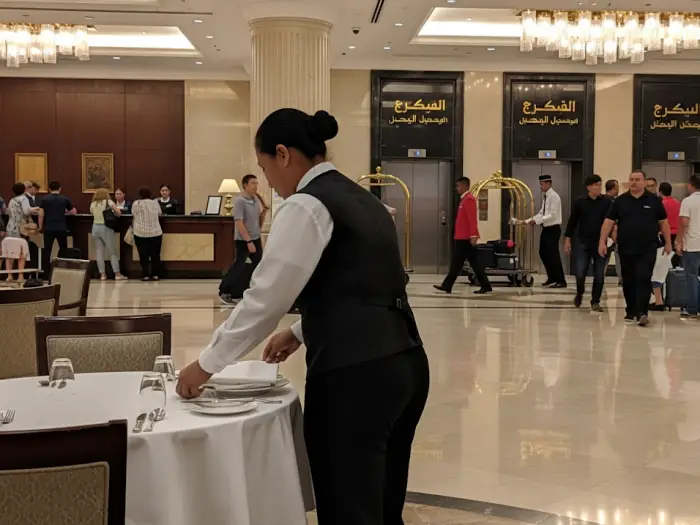
3. Qatar
Qatar may be a small country in the Middle East, but it has one of the highest per-capita incomes in the world and continues to be a solid OFW destination in 2025. The government has been heavily investing in infrastructure, healthcare, and hospitality, creating steady demand for Filipino workers across multiple sectors. For many kababayan, Qatar is appealing because of its tax-free salaries, relatively modern lifestyle, and strict labor reforms introduced in recent years to improve worker rights.
For OFWs with the Super Saver goal, Qatar offers the same advantage as Saudi and UAE – free housing, food allowances, and transportation are often covered by employers. Unlike Saudi, however, the social environment is a bit more relaxed, making it easier for Filipinos to adjust.
In-Demand Jobs in 2025
-
Domestic helpers and household workers
-
Construction workers, welders, drivers, electricians
-
Nurses, caregivers, and medical technicians
-
Hospitality and tourism staff (hotels, restaurants)
-
Engineers and skilled trades for infrastructure projects
Salary Ranges (Approx. 2025)
-
Domestic Helpers: QAR 1,500–2,000/month (₱23,000–₱31,000)
-
Nurses: QAR 7,000–9,000/month (₱108,000–₱140,000)
-
Construction Workers: QAR 2,500–3,500/month (₱38,000–₱53,000)
-
Hotel Staff: QAR 2,500–4,000/month (₱38,000–₱60,000)
(1 QAR ≈ ₱15.5)
Compared to wages in the Philippines, Qatar offers 3x to 6x higher earnings, with strong saving potential thanks to the tax-free system.
Benefits and Worker Rights
-
Tax-free salaries with no personal income tax
-
Many contracts include free or subsidized housing and meals
-
Improved worker rights after recent reforms: minimum wage law, contracts regulated by the Ministry of Labor, and better oversight on working conditions
-
Healthcare access for most jobs, especially in formal contracts
-
Large Filipino community presence – OFWs make up a significant part of Qatar’s workforce, creating support networks for kababayans
Reality Check: Challenges to Expect
-
High cost of independent living – if housing isn’t provided, rent and utilities can eat into your income
-
Shared accommodations – even if free, some workers face cramped conditions
-
Extreme climate – summers can reach over 45°C, tough for outdoor workers
-
Limited residency options – unlike Canada or Australia, Qatar doesn’t offer permanent migration pathways; contracts are usually short-term
-
Strict rules still apply – while less conservative than Saudi, Qatar enforces cultural respect and legal restrictions
Quick Tips for OFWs Headed to Qatar
-
Clarify your housing, food, and transportation benefits before signing the contract; these make a big difference in your savings
-
Use only POEA-licensed agencies and verify job orders with the DMW to avoid scams
-
Prepare for the weather – hydration and protective gear are essential for outdoor jobs
-
Learn simple Arabic terms (greetings, numbers, common phrases) to make daily life easier
-
Connect with Filipino groups in Qatar – many provide community support, job referrals, and even financial literacy seminars

4. Canada
Canada has consistently ranked as one of the most desirable destinations for OFWs, and in 2025 it remains a top choice. Unlike Middle Eastern countries that focus on short-term contracts, Canada offers clear pathways to permanent residency (PR) and citizenship. For Filipinos who want to migrate with their families and build a future abroad, Canada is the ultimate “Immigrant Goal” destination.
The Canadian government has ongoing labor shortages, particularly in healthcare, caregiving, and skilled trades. Filipinos are highly favored in these sectors because of their training, English proficiency, and work ethic. On top of that, Canada has strong labor protections, social benefits, and inclusive multicultural communities where Filipinos are one of the largest immigrant groups.
In-Demand Jobs in 2025
-
Nurses, caregivers, and healthcare professionals
-
Skilled trades (welders, electricians, mechanics, plumbers)
-
IT professionals and engineers
-
Hospitality and service industry workers
-
Truck drivers and logistics staff
Salary Ranges (Approx. 2025)
-
Caregivers: CAD 2,200–2,800/month (₱95,000–₱120,000)
-
Nurses: CAD 4,500–6,500/month (₱190,000–₱275,000)
-
Welders/Skilled Trades: CAD 3,500–4,500/month (₱150,000–₱190,000)
-
Truck Drivers: CAD 3,800–4,800/month (₱160,000–₱205,000)
(1 CAD ≈ ₱42)
These salaries may seem high, but it’s worth noting that Canada’s cost of living is also higher. The difference is that workers have access to social benefits and the ability to stay long-term with their families.
Benefits and Worker Rights
-
Clear pathways to permanent residency through caregiver programs, skilled worker programs, and provincial nominee programs
-
Access to universal healthcare
-
Labor protections for fair wages, regulated work hours, and benefits like paid leave
-
Opportunity to bring family members under certain visa categories
-
Inclusive and multicultural communities where Filipino associations and churches are widespread
Reality Check: Challenges to Expect
-
High cost of living, especially in major cities like Toronto and Vancouver (rent, groceries, and transportation can take up a large portion of your income)
-
Long and competitive application process – visas can take months or even years depending on the program
-
Weather adjustment – harsh winters with heavy snow and sub-zero temperatures can be difficult for first-time migrants
-
Upfront costs – application fees, language tests, and credential assessments add to the total expenses before you can deploy
Quick Tips for OFWs Headed to Canada
-
If your long-term goal is migration, aim for sectors with PR pathways (healthcare, caregiving, skilled trades)
-
Prepare all requirements early – IELTS language exams, ECA (Educational Credential Assessment), and complete documentation
-
Research which province aligns best with your skills; some provinces have special nominee programs for in-demand jobs
-
Connect with Filipino communities in advance – they can provide guidance on housing, schools, and job hunting
-
Budget realistically – even with high salaries, you’ll need financial discipline in your first year due to settlement costs
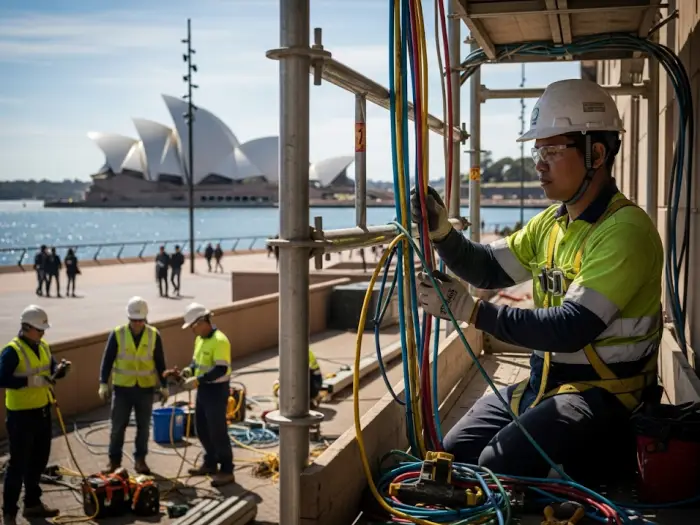
5. Australia
Australia is one of the top migration destinations for Filipinos in 2025, not just for temporary work but for long-term settlement. Its strong economy, high quality of life, and well-defined immigration pathways make it ideal for Filipinos who dream of becoming permanent residents and eventually citizens. Many OFWs begin as temporary workers or students and later transition into skilled migration programs. With growing labor shortages in healthcare, construction, agriculture, and education, Filipinos are in demand more than ever.
Unlike the Middle East where contracts are short-term, Australia offers Filipinos the chance to bring their families, enjoy world-class healthcare and education, and live in a multicultural society where Pinoys already thrive in large numbers.
In-Demand Jobs in 2025
-
Healthcare workers (nurses, aged care, allied health)
-
Skilled trades (electricians, plumbers, welders, carpenters)
-
Teachers and early childhood educators
-
Agriculture and farm workers
-
IT professionals and engineers
Salary Ranges (Approx. 2025)
-
Registered Nurses: AUD 5,500–7,000/month (₱205,000–₱260,000)
-
Skilled Trades (electricians, welders, carpenters): AUD 4,500–6,000/month (₱167,000–₱223,000)
-
Teachers: AUD 5,000–6,500/month (₱185,000–₱240,000)
-
Farm Workers: AUD 3,000–4,000/month (₱112,000–₱150,000)
(1 AUD ≈ ₱37)
These salaries are significantly higher than Philippine wages, but Australia’s real advantage is the potential for permanent residency and citizenship, which allows long-term financial stability.
Benefits and Worker Rights
-
Clear PR pathways through skilled migration programs and employer sponsorships
-
Strong labor laws: regulated work hours, paid leave, overtime, and penalty rates
-
Universal healthcare through Medicare
-
Access to high-quality public education for children
-
Inclusive and multicultural society with large Filipino communities, especially in Sydney, Melbourne, and Brisbane
Reality Check: Challenges to Expect
-
High cost of living, particularly housing in major cities
-
Strict application requirements – many roles require credential recognition and passing English exams (IELTS, PTE)
-
Long processing times for visas and migration applications
-
Competitive job market – many roles require specific qualifications or Australian-recognized licenses
-
Climate differences – hot summers, colder winters than the Philippines, plus rural areas may feel isolated
Quick Tips for OFWs Headed to Australia
-
Aim for jobs listed in the Skilled Occupation List (healthcare, trades, teachers) to increase PR chances
-
Prepare for IELTS or PTE English exams early – language scores are critical for migration applications
-
Have your qualifications assessed by Australian authorities (e.g., AHPRA for nurses) before applying
-
Research regional migration programs – some provinces make it easier for skilled migrants to gain residency
-
Network with Filipino communities in Australia; many provide support for newcomers adjusting to work and life
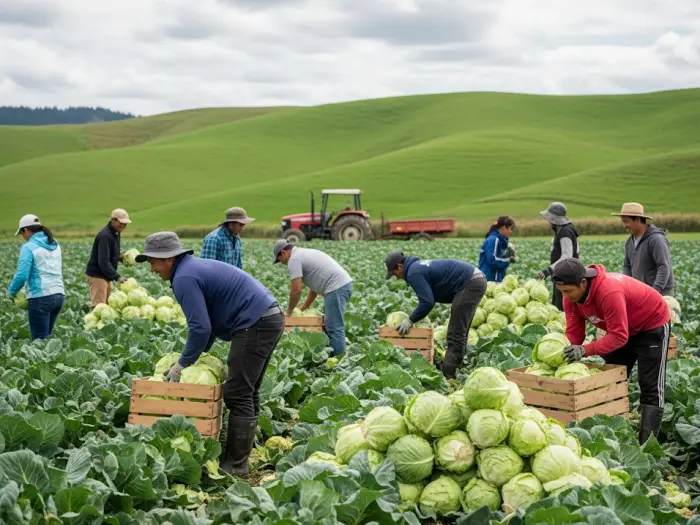
6. New Zealand
New Zealand may be smaller than Australia, but it’s one of the most welcoming countries for migrants. Known for its safe environment, relaxed lifestyle, and strong demand for foreign workers, it’s especially appealing for Filipinos who want both a stable income and a long-term future abroad. The country has clear work-to-residency pathways, meaning many OFWs can eventually apply for permanent residency after working for a few years in high-demand jobs.
For Filipinos with families, New Zealand is attractive because of its world-class public healthcare, quality education, and multicultural communities where Filipinos already form a strong presence. Many kababayan describe life here as “mas tahimik at mas simple” compared to bigger, busier countries.
In-Demand Jobs in 2025
-
Nurses, caregivers, and healthcare staff
-
Skilled trades (welders, carpenters, electricians, mechanics)
-
Agriculture and dairy farm workers
-
Teachers and early childhood educators
-
IT and engineering roles in specialized fields
Salary Ranges (Approx. 2025)
-
Nurses: NZD 5,500–7,000/month (₱190,000–₱240,000)
-
Caregivers: NZD 3,500–4,500/month (₱120,000–₱155,000)
-
Skilled Trades (carpenters, electricians): NZD 4,500–6,000/month (₱155,000–₱205,000)
-
Farm Workers: NZD 3,000–4,000/month (₱105,000–₱140,000)
(1 NZD ≈ ₱35)
While these salaries are slightly lower than Australia’s, New Zealand offers a lower cost of living in many regions, which helps balance out savings potential.
Benefits and Worker Rights
-
Work-to-Residency programs available for in-demand sectors
-
Strong worker protections and fair employment contracts
-
Public healthcare system covers permanent residents and many visa holders
-
High-quality, low-cost education for children
-
Safe, peaceful environment with low crime rates
-
Active Filipino communities in Auckland, Wellington, Christchurch, and smaller towns
Reality Check: Challenges to Expect
-
Smaller job market compared to Australia – competition can be tougher for certain professions
-
Strict credential recognition – nurses, teachers, and tradespeople often need to meet local licensing requirements
-
Weather adjustment – cold winters and frequent rains may be difficult for some Filipinos
-
Distance and isolation – fewer flights and longer travel time back to the Philippines compared to other destinations
-
Higher taxes than Middle Eastern countries, which slightly reduces take-home pay
Quick Tips for OFWs Headed to New Zealand
-
Focus on in-demand occupations to maximize your chances of getting a visa with residency options
-
Prepare for English proficiency exams (IELTS, PTE) as they are part of the immigration process
-
For healthcare and trades, start credential recognition early – it can take months to process
-
Look into regional jobs outside Auckland and Wellington, where demand is high and living costs are lower
-
Connect with Pinoy organizations in your city – they often help newcomers find housing, schools, and job opportunities

7. United Kingdom
The United Kingdom remains one of the most sought-after destinations for Filipino healthcare workers in 2025. With its National Health Service (NHS) struggling with staff shortages, there is a massive demand for nurses, caregivers, and allied health professionals. For Filipinos, the UK offers more than just high salaries – it provides globally recognized experience that can open doors anywhere in the world.
Unlike the Middle East where contracts are temporary, the UK allows longer-term opportunities. While the pathway to permanent residency is stricter compared to Canada or Australia, many Filipinos choose the UK to build their careers, strengthen their credentials, and earn well in a developed economy.
In-Demand Jobs in 2025
-
Nurses and healthcare professionals (the largest demand)
-
Caregivers and senior carers
-
Medical technicians and allied health staff
-
Hospitality and service industry workers (secondary demand)
-
IT and finance roles for highly skilled migrants
Salary Ranges (Approx. 2025)
-
Nurses: £2,400–3,000/month (₱165,000–₱205,000)
-
Senior Carers: £1,800–2,300/month (₱125,000–₱160,000)
-
Hospitality Workers: £1,600–2,000/month (₱110,000–₱140,000)
(1 GBP ≈ ₱69)
Though cost of living is high in cities like London, many Filipinos still manage to save because housing allowances, overtime, and night shift pay are common in healthcare roles.
Benefits and Worker Rights
-
Regulated work contracts with paid holidays, sick leave, and pension contributions
-
Access to NHS healthcare system for employees
-
Strong labor protections and worker unions
-
Additional allowances for overtime, night shifts, and weekend work
-
Chance to bring dependents under some visa categories
-
Valuable international experience that boosts career prospects worldwide
Reality Check: Challenges to Expect
-
High cost of living – London and other major cities are expensive for rent and daily expenses
-
Visa process can be strict – language exams (IELTS, OET) and credential recognition are required for healthcare professionals
-
Weather and lifestyle adjustment – cold winters, less sunshine, and a fast-paced lifestyle may be difficult for first-time OFWs
-
Limited residency options – possible, but not as straightforward as Canada or Australia
-
Homesickness – distance from the Philippines and cultural differences can be challenging
Quick Tips for OFWs Headed to the UK
-
Focus on healthcare roles if possible – these have the strongest demand and clearest visa routes
-
Prepare early for IELTS/OET exams – required for nurses and healthcare workers
-
Explore work outside London – cities like Manchester, Birmingham, or Leeds offer lower costs of living
-
Join Filipino associations in the UK for housing tips, legal guidance, and emotional support
-
Plan finances carefully – while salaries are good, high expenses can reduce savings if not managed well
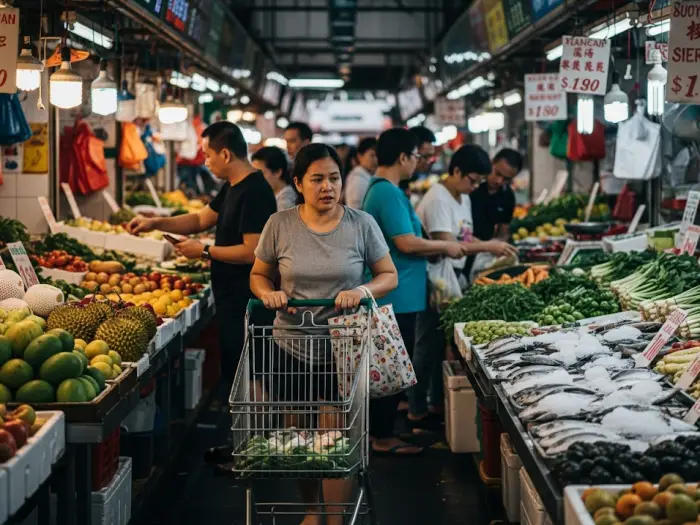
8. Singapore
Singapore has been one of the most reliable hubs for OFWs for decades, and in 2025 it remains a top choice thanks to its strong economy, proximity to the Philippines, and demand for both skilled and household workers. For Filipinos who want to gain global career experience while staying close to home, Singapore is one of the best options.
Its multicultural environment makes adjustment easier, and its labor laws provide protection for foreign workers. While the cost of living is high, salaries are also competitive, and many employers provide housing for domestic helpers, allowing them to save more. For skilled workers in IT, finance, and engineering, Singapore offers world-class experience that boosts long-term career growth.
In-Demand Jobs in 2025
-
Domestic helpers and household service workers (large demand continues)
-
Nurses, caregivers, and healthcare staff
-
IT professionals and engineers
-
Finance, banking, and administrative workers
-
Hospitality and food service staff
Salary Ranges (Approx. 2025)
-
Domestic Helpers: SGD 600–800/month (₱25,000–₱34,000, with free housing and food)
-
Nurses: SGD 3,500–5,000/month (₱145,000–₱210,000)
-
IT Professionals: SGD 4,000–6,000/month (₱165,000–₱250,000)
-
Hospitality Staff: SGD 2,000–3,000/month (₱83,000–₱125,000)
(1 SGD ≈ ₱41)
The big advantage is that Singapore is only a few hours away by plane, making it easier for Filipinos to visit home compared to faraway destinations.
Benefits and Worker Rights
-
Strong labor laws protecting foreign workers, especially domestic helpers (mandatory rest days, contract regulations)
-
Many employers provide free housing and meals for household workers
-
Regulated healthcare coverage and insurance for foreign workers
-
Efficient and modern working environment – excellent for career growth in IT, finance, and engineering
-
Large Filipino community with support networks, churches, and social groups
Reality Check: Challenges to Expect
-
High cost of living, especially for those who rent housing (skilled workers without employer-provided housing need to budget carefully)
-
Strict rules – Singapore enforces laws very seriously, from chewing gum bans to littering fines
-
Competitive job market – many foreign workers compete for skilled roles, and preference is sometimes given to citizens or permanent residents
-
Limited long-term residency – difficult to migrate permanently unless in highly skilled sectors
-
Work pressure – the pace of life and work in Singapore can be fast and demanding
Quick Tips for OFWs Headed to Singapore
-
If you’re applying as a domestic helper, work only through POEA-accredited agencies and ensure contracts clearly state salary, rest days, and benefits
-
Skilled workers should focus on IT, engineering, and finance roles, which are highly valued in Singapore’s economy
-
Budget wisely – while salaries are higher, living costs (especially rent) can quickly eat into earnings
-
Take advantage of Singapore’s proximity to the Philippines – many OFWs appreciate being able to fly home for visits affordably
-
Join Filipino communities and organizations for emotional support, networking, and practical tips on adjusting to city life

9. Japan
Japan continues to be one of the most attractive destinations for Filipinos in 2025 because of its Technical Intern Training Program (TITP) and Specified Skilled Worker (SSW) visa programs. These pathways allow Filipinos to gain skills, earn decent salaries, and potentially extend their stay long-term. With Japan’s rapidly aging population, there’s huge demand for caregivers, healthcare staff, and other skilled workers.
For Filipinos, Japan offers the chance to develop specialized skills in caregiving, manufacturing, and engineering while working in a highly advanced economy. Experience here is highly respected and opens doors to opportunities in other countries later on.
In-Demand Jobs in 2025
-
Caregivers and healthcare staff
-
Factory and manufacturing workers
-
Construction and skilled trades
-
Hotel, food service, and hospitality staff
-
IT and engineering (growing demand in tech sectors)
Salary Ranges (Approx. 2025)
-
Caregivers: ¥180,000–220,000/month (₱70,000–₱85,000)
-
Factory Workers: ¥160,000–200,000/month (₱62,000–₱78,000)
-
IT Engineers: ¥250,000–350,000/month (₱97,000–₱135,000)
(1 JPY ≈ ₱0.39)
While salaries aren’t as high as Canada or Australia, Japan’s reputation as a Skill Builder country lies in the training, experience, and strict workplace standards that Filipinos gain here.
Benefits and Worker Rights
-
Access to health insurance and social welfare benefits as part of employment
-
Structured training under TITP and opportunities for longer stays under SSW visas
-
Clear contracts regulated by the Japanese and Philippine governments
-
Strong workplace protections and standardized working conditions
-
Opportunities for skills certification that can be used globally
Reality Check: Challenges to Expect
-
Language barrier – Japanese language proficiency (N4–N3 level) is usually required before deployment
-
High cost of living in big cities like Tokyo and Osaka; housing and transport can take a significant portion of income
-
Cultural adjustment – Japanese workplaces are highly disciplined, with strict rules and expectations
-
Temporary nature of some visas – TITP is limited to a few years unless upgraded to SSW or other work visas
-
Homesickness – while Japan is closer than Europe or the US, the cultural gap can be challenging
Quick Tips for OFWs Headed to Japan
-
Enroll in a Japanese language course (N4 or higher) before applying to increase your chances of selection
-
Focus on caregiver and factory jobs, which have the highest demand under current visa programs
-
Budget wisely – cost of living in Japan is high, so maximize savings by living modestly
-
Take advantage of skills certification and training opportunities that can strengthen your resume for future jobs abroad
-
Build connections with Filipino communities in Japan – they can help with job advice, housing, and moral support

10. Germany
Germany is one of Europe’s most powerful economies, and in 2025 it continues to open doors for Filipinos through its demand for healthcare workers, skilled tradespeople, and technical professionals. The German government has been actively recruiting foreign workers to address labor shortages, especially in nursing and caregiving. For Filipinos, Germany represents a chance to gain European-standard skills and experience, earn well, and potentially build a long-term career in Europe.
Unlike Middle Eastern countries, Germany offers strong labor protections, regulated contracts, and the prestige of working in the European Union. While learning German is a requirement, those who succeed enjoy opportunities that can lead to permanent residency and long-term stability.
In-Demand Jobs in 2025
-
Nurses and caregivers (the largest demand)
-
Skilled trades (mechanics, electricians, welders, plumbers)
-
IT professionals and engineers
-
Hospitality and food service staff (secondary demand)
-
Logistics and truck drivers
Salary Ranges (Approx. 2025)
-
Nurses: €2,500–3,500/month (₱150,000–₱210,000)
-
Caregivers: €1,800–2,400/month (₱110,000–₱145,000)
-
Skilled Trades: €2,500–3,200/month (₱150,000–₱190,000)
-
IT Professionals: €3,000–4,500/month (₱180,000–₱270,000)
(1 EUR ≈ ₱60)
These salaries are competitive compared to other destinations, but the real value lies in the world-class training, European work experience, and career progression.
Benefits and Worker Rights
-
Strong labor protections under German law (regulated hours, paid leave, overtime pay)
-
Access to healthcare and social security benefits
-
Opportunities for long-term work visas and potential permanent residency for qualified workers
-
High-quality education and healthcare for families of migrant workers
-
Experience in Germany can open doors to other EU countries
Reality Check: Challenges to Expect
-
Language barrier – German proficiency (at least B1 level) is usually required before deployment
-
Cost of living is moderate to high depending on the city (Berlin and Munich are more expensive)
-
Strict credential recognition – nurses and skilled trades need certifications validated by German authorities
-
Cultural adjustment – work culture is very disciplined and punctual, which can feel rigid for Filipinos
-
Migration process can be lengthy – securing visas, language exams, and training may take months or years
Quick Tips for OFWs Headed to Germany
-
Start learning German early – language ability is the biggest hurdle but also your key to success
-
Focus on healthcare and skilled trades, which are the top shortage areas
-
Prepare for credential recognition – nurses must have PRC licenses evaluated before deployment
-
Research cost of living in your target city and plan finances accordingly
-
Connect with Filipino communities in Germany for guidance, especially those in healthcare and skilled trades
Comparison of Top 10 OFW Destinations in 2025
| Country | Avg. Salary Range (₱) | In-Demand Jobs | Key Benefits | Main Challenges |
|---|---|---|---|---|
| Saudi Arabia | ₱22,000–₱150,000 | Domestic helpers, nurses, construction, engineers | Tax-free income, free housing & food | Strict culture, limited freedoms, risk of contract abuse |
| UAE (Dubai/Abu Dhabi) | ₱22,500–₱135,000 | Domestic helpers, nurses, hospitality, IT | Tax-free, modern lifestyle, big Filipino community | High cost of living, competitive job market |
| Qatar | ₱23,000–₱140,000 | Domestic helpers, construction, healthcare | Tax-free, labor reforms, free housing/meals | Harsh climate, limited residency options |
| Canada | ₱95,000–₱275,000 | Nurses, caregivers, skilled trades, drivers | Clear PR pathway, universal healthcare, family migration | Expensive cost of living, long process |
| Australia | ₱112,000–₱260,000 | Nurses, trades, teachers, agriculture, IT | Strong PR programs, labor protections, multicultural society | High rent, strict licensing, competitive |
| New Zealand | ₱105,000–₱240,000 | Nurses, caregivers, trades, farm work | Work-to-residency, safe and family-friendly | Smaller job market, weather adjustment |
| United Kingdom | ₱110,000–₱205,000 | Nurses, caregivers, healthcare, hospitality | Globally recognized healthcare experience, labor protections | High cost of living, strict visa/IELTS requirements |
| Singapore | ₱25,000–₱250,000 | Domestic helpers, nurses, IT, finance, hospitality | Close to PH, career growth, labor protections | High cost of living, limited PR options |
| Japan | ₱62,000–₱135,000 | Caregivers, factory workers, trades, IT | Skills training, advanced workplace standards | Language barrier, temporary visa programs |
| Germany | ₱110,000–₱270,000 | Nurses, caregivers, skilled trades, IT | EU work experience, labor protections, PR potential | German language required, strict credential checks |
🧭 How to Choose the Right Country for You
Every OFW has a unique reason for leaving home. Some want to save money quickly, others dream of migrating with their family, while many see overseas work as a stepping stone to a bigger career. There’s no single “best” country – only the country that best fits your personal goal. Here’s how to decide:
💰 If Your Goal is to Save as Much Money as Possible (Super Saver)
You want to maximize remittances, not lifestyle. The Middle East is unbeatable here because salaries are tax-free and many employers cover housing, food, and even transportation. Your day-to-day gastos are minimal, so most of your paycheck goes straight home.
-
Best Fits: Saudi Arabia, UAE, Qatar
-
Perfect For: Domestic helpers, construction workers, skilled trades
-
Diskarte Tip: Don’t just look at the base salary – always confirm the benefits. A free room and meals can easily save you ₱10,000–₱15,000 a month compared to paying out of pocket.
Example: A domestic helper in Saudi earning SAR 1,800/month (₱27,000) with free housing and meals can remit ₱20,000–₱22,000 monthly. In contrast, someone in Singapore earning SGD 700 (₱29,000) but paying their own rent and food might save less.
🏡 If Your Goal is to Migrate Permanently (Immigrant Goal)
You’re not just working abroad for a few years – you want to bring your family, settle down, and build a new life. This requires countries with clear immigration programs that lead to permanent residency and eventually citizenship. These pathways may take longer and cost more upfront, but they’re the best for long-term stability.
-
Best Fits: Canada, Australia, New Zealand
-
Perfect For: Nurses, caregivers, teachers, skilled trades, professionals
-
Diskarte Tip: Target jobs listed in the country’s official shortage occupation list. Being in-demand not only speeds up visa approvals but also increases your PR chances.
Example: A caregiver in Canada may earn around ₱100,000/month, but the real benefit is the Caregiver to Permanent Resident Program, which allows workers to apply for PR after just 2 years of work experience.
📈 If Your Goal is to Gain Skills and Build Your Career (Skill Builder & Career Climber)
You want world-class training and experience that will boost your career anywhere you go. These countries may not always offer PR easily, but they provide globally recognized credentials that can open doors to higher-paying roles in the future – whether abroad or back home in the Philippines.
-
Best Fits: United Kingdom, Singapore, Japan, Germany
-
Perfect For: Healthcare workers, IT professionals, engineers, hospitality workers
-
Diskarte Tip: Be ready to invest in language exams and certifications. They may feel like obstacles, but they’re actually stepping stones that raise your value in the global job market.
Example: A nurse who works in the UK’s NHS gains training and experience that makes them highly employable not just in the UK, but also in Canada, the Middle East, and even private hospitals in the Philippines.
❓ Frequently Asked Questions about OFW Destinations in 2025
-
Which country pays OFWs the highest salary in 2025?
Salaries are generally highest in countries like Canada, Australia, and Germany, especially for healthcare workers and skilled trades. Nurses, for example, can earn ₱190,000–₱275,000 in Canada, while engineers and IT staff in Germany can also reach ₱200,000+. However, don’t forget that living costs are higher in these places, so savings potential depends on your expenses too. -
What is the easiest country to apply to for Filipinos?
Middle Eastern countries such as Saudi Arabia, UAE, and Qatar are usually easier and faster to apply for since demand is high and requirements are simpler. Jobs there are mostly processed through POEA-licensed agencies, and deployment can take just a few months. Western countries require stricter exams, credential recognition, and longer application times. -
Do all countries provide free food and housing for OFWs?
Not all. Free food and housing are common in the Middle East, especially for domestic helpers and construction workers, which is why they’re considered “Super Saver” destinations. In countries like Canada or Australia, workers cover their own rent and food, but salaries are higher to balance it out. -
What are the safest countries for Filipino workers?
New Zealand, Canada, and Singapore are often rated as very safe for foreign workers, with low crime rates and strong worker protections. These countries also have active Filipino communities that help newcomers adjust. Middle Eastern countries are generally safe too, but cultural and legal restrictions may feel strict. -
Can OFWs bring their families abroad?
Yes, but it depends on the country and visa type. Canada, Australia, and New Zealand have clear family sponsorship programs, allowing workers to eventually bring spouses and children. In the Middle East and some Asian countries, bringing family members is usually not allowed for lower-income jobs. -
Which country has the biggest Filipino community?
Saudi Arabia still has the largest concentration of OFWs, with over a million Filipinos working there. Other countries with strong Filipino communities include the UAE, Canada, and Hong Kong. Having a big Pinoy community helps with adjustment, networking, and emotional support. -
Do I need TESDA training to work abroad?
For certain jobs, yes. Household service workers are required to have TESDA NC II training before deployment, while caregivers and skilled trades often need certifications too. For professionals like nurses or engineers, international credential recognition is more important than TESDA. -
How much does it cost to apply as an OFW?
Costs vary depending on the country and job. For Middle East jobs, you may spend ₱20,000–₱40,000 for medical, NBI clearance, and training, with many employers covering airfare. For Western countries, upfront costs are higher (₱100,000+), including exams, credential recognition, and visa fees. -
Can I apply abroad without an agency?
Direct hiring is possible in some cases, like Canada’s caregiver program or if you have an employer who processes your papers directly. However, most OFWs are deployed through POEA-licensed agencies to ensure contracts are legal and workers are protected. Avoid applying through unregistered recruiters to prevent scams. -
What should I do if I encounter an illegal recruiter?
Report them immediately to the Department of Migrant Workers (DMW, formerly POEA). Illegal recruiters often ask for placement fees that exceed the legal limit or promise jobs that don’t exist. Always verify the agency’s license number and check official job postings before paying anything.
📚 References
-
“Deployed Landbased Overseas Filipino Workers by Top 10 Destinations …” – Department of Migrant Workers, 2024-2025 data showing number of OFWs deployed to top destinations (Saudi Arabia, UAE, Singapore, etc.). dmw.gov.ph
-
“Deployed Landbased Overseas Filipino Workers by Major World Group …” – shows OFW deployment by region (Middle East, Asia, Europe, etc.). dmw.gov.ph
-
“Survey on Overseas Filipinos” – Philippine Statistics Authority, showing current number of OFWs. Philippine Statistics Authority
-
“OFW Remittances up 2.7% in Q1” – Bangko Sentral ng Pilipinas / PIDS, showing remittance growth and noting demand in specific sectors abroad. PIDS
-
“5 Best Countries and Job Opportunities Abroad for Filipinos” – Yarra agency article, recent job opportunities (Saudi, UAE, Canada, Japan, Australia) mentioned. Yarra Internatinal Recruitment Co Inc.
🌟 Making the OFW Journey Count
Choosing where to work abroad is one of the biggest decisions a Filipino can make. It’s not just about chasing a high salary – it’s about aligning your choice with your life goal. If your dream is to save fast and build a house in the province, the Middle East might be your best bet. If you want to bring your family and start fresh abroad, then Canada, Australia, or New Zealand will give you that pathway. And if your heart is set on climbing the career ladder and gaining world-class experience, places like the UK, Singapore, Japan, or Germany can put you on that track.
Whatever path you choose, remember this: being an OFW is never just about the money. It’s about sacrifice, resilience, and the hope of a better tomorrow. Each remittance you send, each challenge you face, and each skill you gain brings you closer to your goal.
So before you pack your bags, ask yourself – What’s my purpose? Once you’re clear on that, the right country won’t just be a workplace, it will be the stepping stone to the future you’re building for yourself and your family.



